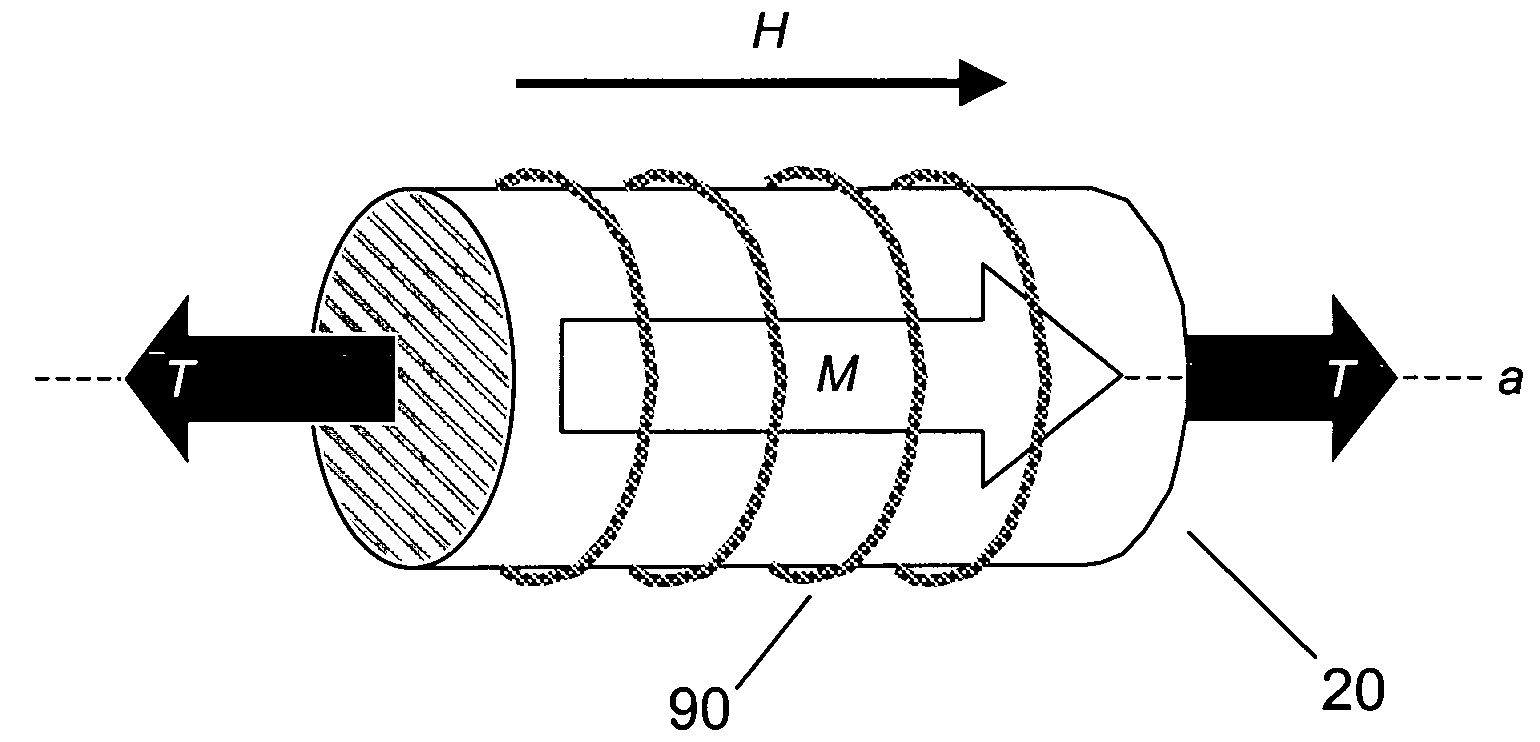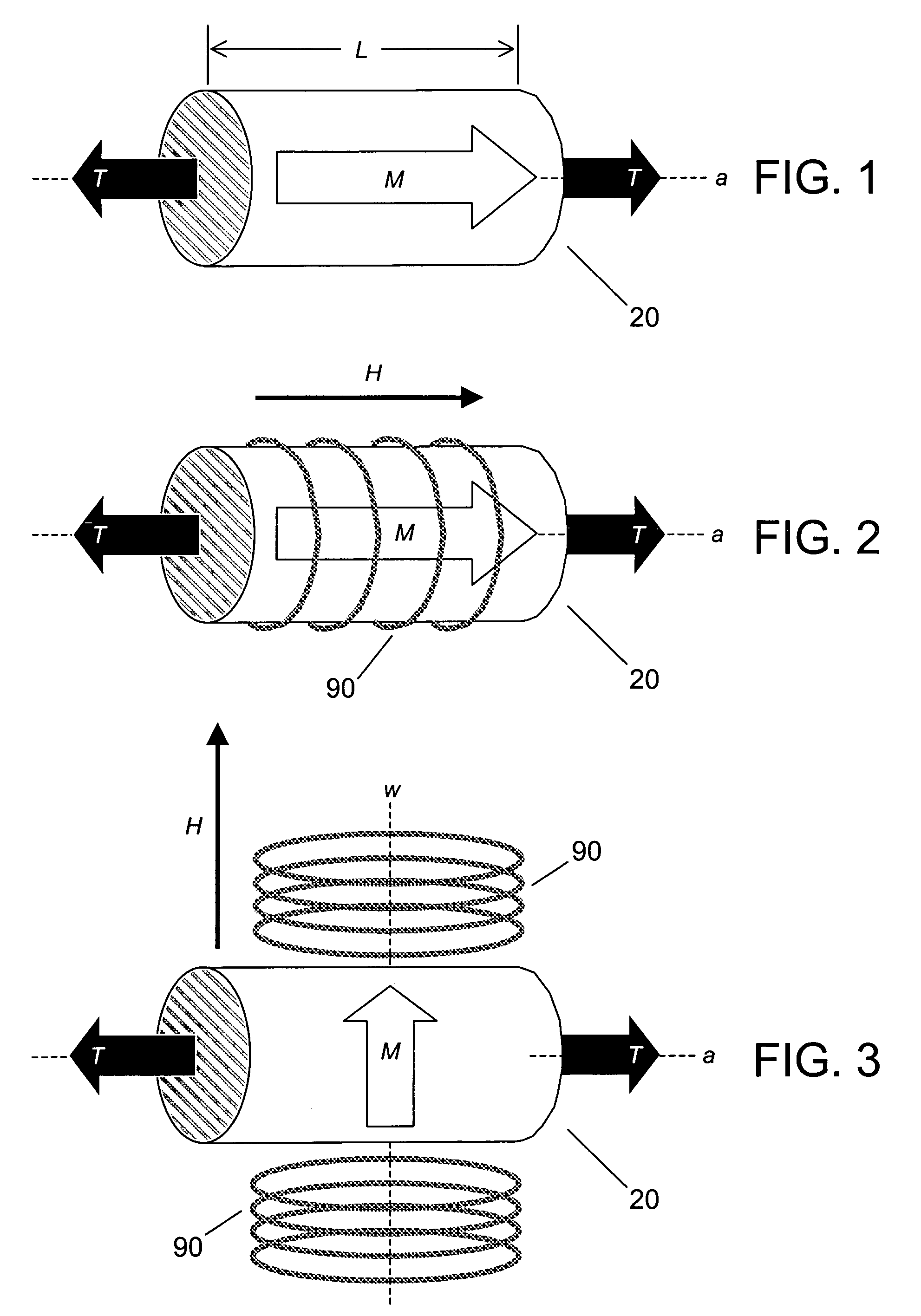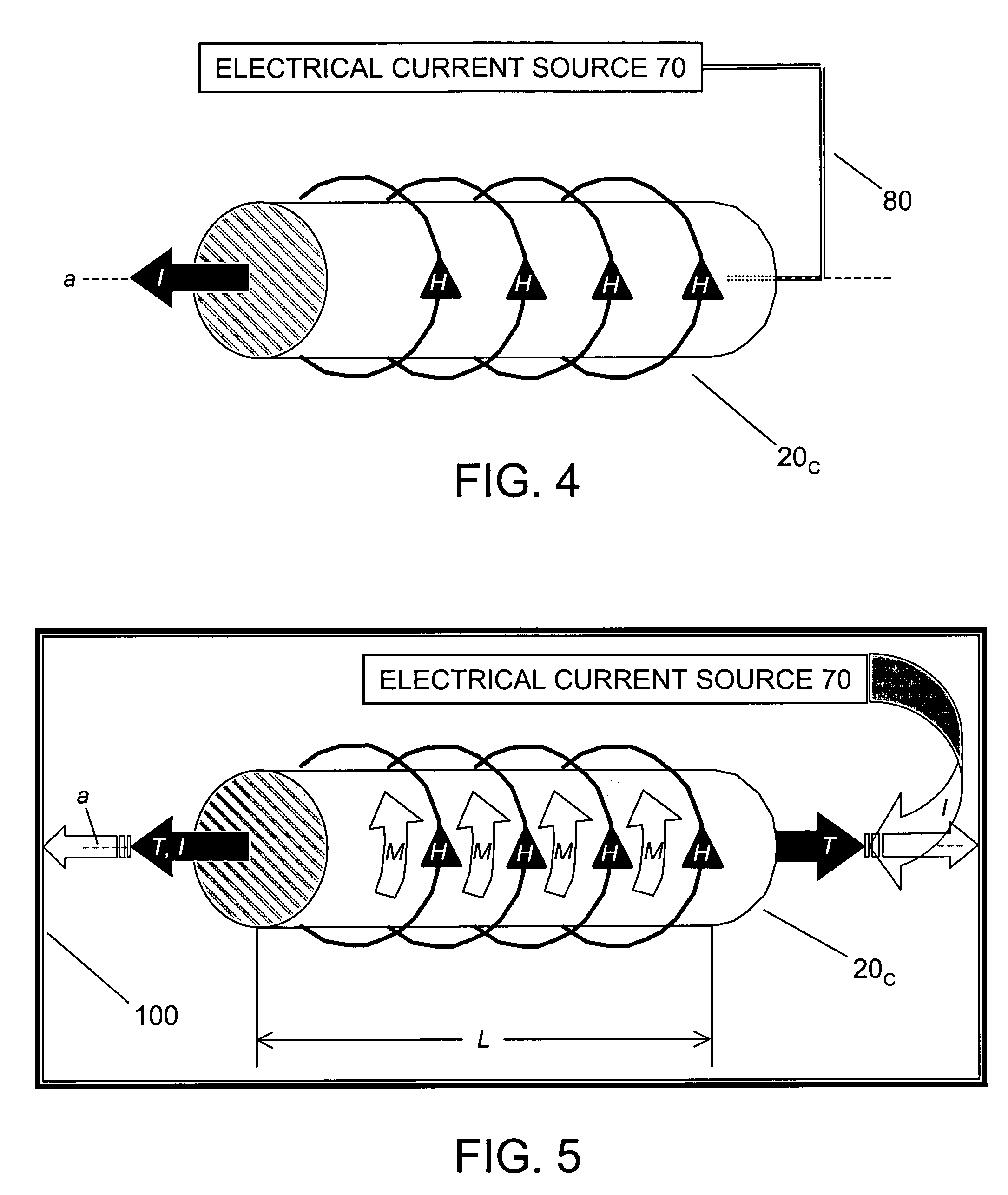High magnetostriction of positive magnetostrictive materials under tensile load
a technology of positive magnetostrictive materials and tensile load, applied in the field of magnetostriction, can solve the problems that conventional methods do not work for positive magnetostrictive materials under tensile load
- Summary
- Abstract
- Description
- Claims
- Application Information
AI Technical Summary
Benefits of technology
Problems solved by technology
Method used
Image
Examples
example 1
[0050]With reference to FIG. 4 and FIG. 5, in this example the voltage is applied directly to the magnetostrictive material 20c. A load of 40 lb=178 N is applied to a magnetostrictive, electrically conductive wire 20c of single crystal (or highly textured) Fe81Ga19 that is 3 mm (˜⅛ inch) in diameter and 10 meters in length. To calculate the cross-sectional area a of magnetostrictive wire 20c, a=πr2=7.07×10−6 m2. The resistance R of Fe81Ga19 wire=ρ=10 m / a=1.06 Ω. Force F=178 N. The tensile stress T=25.2 MPa. Setting the magnetic and mechanical energies equal, the following equation obtains: M×H=T×Sms. The magnetic field needed, Hav, is calculated as follows: Hav=25.2×106 Pa×300×10−6 / 1.7 T=4450 A / m. The magnetic field at the surface, Hsurface, is assumed to be ≅1.2>Hav=5340 A / m. The current needed is calculated as follows: I=5340 A / m×π0.3×10−2 m=50.3 A. Voltage V=IR=50.3 A×1.06 Ω=53.3 V. Power P=VI=53.3 V×50.3 A=2680 W. Thus, in this case of a small diameter (3 mm), 10 meter Fe81Ga19 ...
example 2
[0051]With reference to FIG. 6 and FIG. 9, in this example a load of 40 lb=178 N is applied to the present invention's integral configuration 40, a cable-like structure that includes a Cu wire core 300 (1.5 mm in diameter) and, surrounding Cu wire 300, a magnetostrictive ring (annulus) 200 (10 meters in length, 3 mm in diameter) made of Fe81Ga19 textured magnetostrictive alloy. Core 300 has a radium of rin; annulus 200 has a radius of rout. The cross-sectional area a of the annular active material 200 is calculated as a=π(rout2−rin2)=5.3×10−6 m2. The resistance R of the Cu wire is calculated as R=0.102 Ω. The force F=178 N. The tensile stress T=33.6 MPa. Setting the magnetic and mechanical energies equal, the following equation obtains: M×H=T×Sms. Magnetic field Hav, the magnetic field needed in the Fe81Ga19 ring 200, is calculated as follows: Hav=33.6×106 Pa×300×10−6 / 1.7=5930 A / m=74.2 Oe. To achieve this, magnetic field Hsurface, the magnetic field at the surface of the copper wire...
example 3
[0052]Still with reference to FIG. 6 and FIG. 9, in this example the Cu wire 300 and the Fe81Ga19 annulus 200 each have twice the diameter as in Example 2. In addition, in this example a larger load of 100 lb=445 N is applied to the present invention's integral configuration 40, which includes Cu core 300 (3 mm in diameter) and Fe81Ga19 annulus 200 (10 meters in length, 6 mm in diameter). The cross-sectional area a of the annular active material 200 is calculated as a=π(rout2−rin2)=2.12×10−5 m2. The resistance R of the Cu wire is calculated as R=0.0255 Ω. The force F=445 N. The tensile stress T=21 MPa. Setting the magnetic and mechanical energies equal, the following equation obtains: M×H=T×Sms. Magnetic field Hav, the magnetic field needed in the Fe81Ga19 ring 200, is calculated as follows: Hav=21×106 Pa×300×10−6 / 1.7 T=3710 A / m=46.6 Oe. To achieve this, magnetic field Hsurface, the magnetic field at the surface of the copper wire core 300, is assumed to be ≅1.5×Hav=5570 A / m. The cu...
PUM
| Property | Measurement | Unit |
|---|---|---|
| diameter | aaaaa | aaaaa |
| diameter | aaaaa | aaaaa |
| diameter | aaaaa | aaaaa |
Abstract
Description
Claims
Application Information
 Login to View More
Login to View More - R&D
- Intellectual Property
- Life Sciences
- Materials
- Tech Scout
- Unparalleled Data Quality
- Higher Quality Content
- 60% Fewer Hallucinations
Browse by: Latest US Patents, China's latest patents, Technical Efficacy Thesaurus, Application Domain, Technology Topic, Popular Technical Reports.
© 2025 PatSnap. All rights reserved.Legal|Privacy policy|Modern Slavery Act Transparency Statement|Sitemap|About US| Contact US: help@patsnap.com



